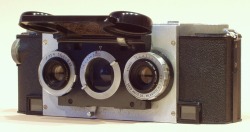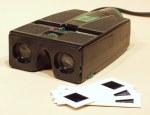The Stereo Realist is a very popular american stereo camera of the 50's.
Stereo Realist
 With about 250 000 units sold, the Stereo Realist is certainly the most popular stereo camera ever made. Engineered by Seton Rochwite during World War II, it has been manufactured by the David White Co., Milwaukee, Wisconsin from 1947 to 1971. The one shown on the picture was made in 1954. The Stereo Realist's success was partly due to the stereo frenzy caused by the success of the Kodachrome slide film on the US market. It was used by a lot of celebrities like Harold Lloyd or Dwight D. Eisenhower.
With about 250 000 units sold, the Stereo Realist is certainly the most popular stereo camera ever made. Engineered by Seton Rochwite during World War II, it has been manufactured by the David White Co., Milwaukee, Wisconsin from 1947 to 1971. The one shown on the picture was made in 1954. The Stereo Realist's success was partly due to the stereo frenzy caused by the success of the Kodachrome slide film on the US market. It was used by a lot of celebrities like Harold Lloyd or Dwight D. Eisenhower.
The Stereo Realist uses standard 135 film. The lenses are two 35 mm f/3.5 coated triplets. One can make 19 couples of pictures on a 24 exposures film or 29 couples on a 36 exposures film. The 22 x 23 mm format introduced by this camera became the world's standard for stereo slides. The albada finder, located between the lenses, has no parallax. The rangefinder has a wide base (12 cm) and is therefore very accurate. Focusing is made by moving the film plane and not the lenses.
Well made, the Stereo Realist is a reliable camera. It can easily be repaired, being easy to take apart and to understand. The one on the picture had a shutter malfunction, a broken double exposure prevention system and sticky slow speeds. I repaired it in an hour with nothing more than a little screwdriver and a drop of oil. With an average price of US $100, it is one of the best performance/price stereo camera.
Several Stereo Realist models were made. The most common is the 1041 shown here. Less common, the 1042 has better Tessar type f/2.8 lenses. The 1050 (Realist Custom) has even better f/2.8 lenses. The Realist 45 is a low end model made in Germany.
Use
 The Stereo Realist is quite heavy, which can be a problem when one uses it for a long time. The viewfinder is clear and the focusing knob, located on the side of the body, is well placed. But it has no lightmeter, the rangefinder is independant from the viewfinder and the speed and aperture rings are on the front of the body, making this camera slow to use. The f/3.5 triplets have an annoying vignetting from f/11 to f/22. This problem is solved with the f/2.8 Tessar type lenses.
The Stereo Realist is quite heavy, which can be a problem when one uses it for a long time. The viewfinder is clear and the focusing knob, located on the side of the body, is well placed. But it has no lightmeter, the rangefinder is independant from the viewfinder and the speed and aperture rings are on the front of the body, making this camera slow to use. The f/3.5 triplets have an annoying vignetting from f/11 to f/22. This problem is solved with the f/2.8 Tessar type lenses.
Using the Stereo Realist isn't very complicated when one knows how to do it. George A. Themelis gives a very useful description of the use of this camera along with repairing and maintaining tips.
Characteristics
Format |
couple of slides, 22 x 23 mm each, on 135 film |
Lens |
coated 35 mm f/3.5 David White Anastigmat triplet |
Shutter |
behind the lenses, 1/150 s to 1 s, flash sync at all speeds |
Weight |
820 g |
Accessories
|
|
© Vincent Becker 2025 - www.lumieresenboite.com

